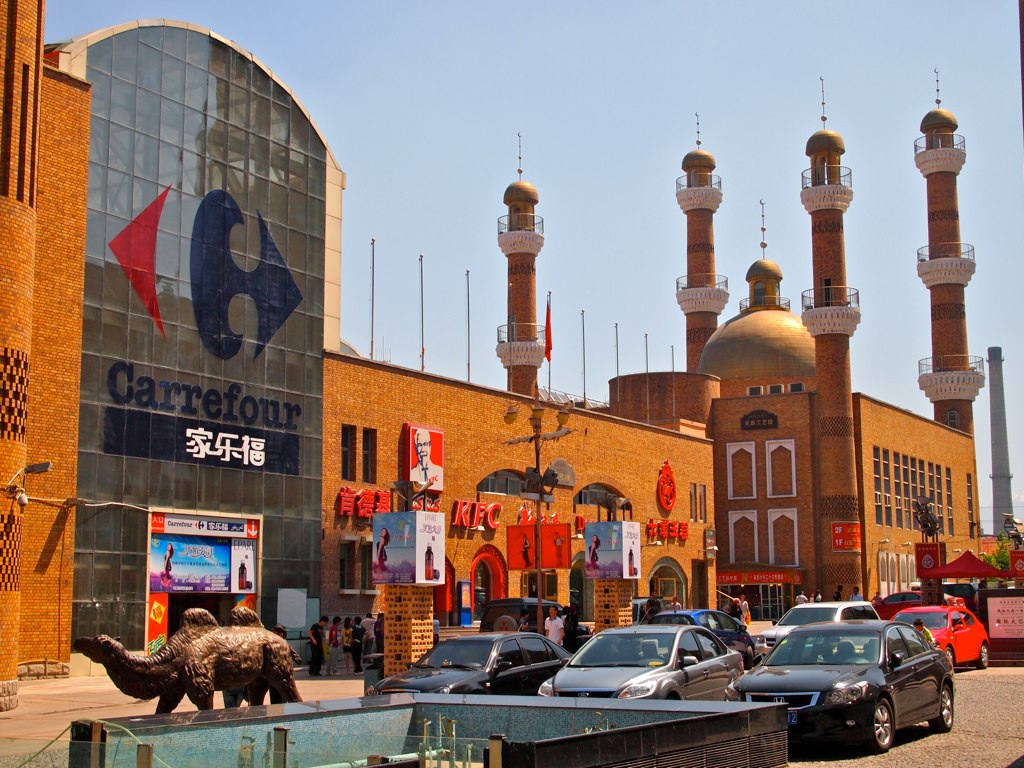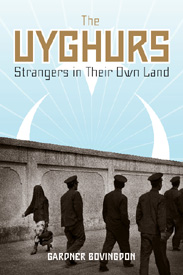
The Uyghurs: Strangers in Their Own Land
by Gardner Bovingdon
—Reviewed by Angilee Shah
 The plight of Uyghurs in China entered U.S. consciousness after 9/11. Since 2002, 22 migrant Uyghurs were detained at Guantánamo Bay after being turned over to the United States by bounty hunters in Pakistan. By 2008, the men were no longer considered enemy combatants. Seventeen of them have been released to Switzerland, Palau, Bermuda and Albania. The United States so far has not accepted any of the innocent detainees, nor is the State Department willing to send them back to China where they would likely be persecuted as separatists.
The plight of Uyghurs in China entered U.S. consciousness after 9/11. Since 2002, 22 migrant Uyghurs were detained at Guantánamo Bay after being turned over to the United States by bounty hunters in Pakistan. By 2008, the men were no longer considered enemy combatants. Seventeen of them have been released to Switzerland, Palau, Bermuda and Albania. The United States so far has not accepted any of the innocent detainees, nor is the State Department willing to send them back to China where they would likely be persecuted as separatists.
What makes relocating innocent men so difficult? Gardner Bovingdon fills a large gap in our understanding and misunderstanding of Uyghurs’ political lives. The Uyghurs, a scholarly history that is both cognizant of the past and relevant to the present, illustrates not only how the minority group was oppressed in the northwest province of Xinjiang, but also how its stories have been twisted to fit a “war on terror” narrative. “Many journalists and government officials throughout the world now routinely depict Uyghur independence activists as terrorists tout court,” Bovingdon writes.
The East Turkestan Islamic Movement, the State Department-designated terrorist organization that the Guantánamo Bay prisoners were accused of supporting, should not be confused with the wider and more disjointed East Turkestan independence movement. What The Uyghurs painstakingly details are the nuances of a deep conflict in China’s northwest, where a largely Muslim and Turkic-speaking ethnic group lacks political freedom and agency in their homeland and fight for a cause unrelated to the aims of Islamist groups proscribed by the United States.
Bovingdon’s history is based on his over 160 interviews and 20 months of field work in Xinjiang, where having conversations about a minority group’s national aspirations and grievances against the Chinese Communist Party is a risky endeavor. Xinjiang covers one-sixth of China’s land and is the resource-rich home to a large population of Uyghurs, whose cultures and customs are distinct from the majority Han population of greater China. In the deep conflict between Uyghurs and the Chinese state, even the name of the region is contested. Officially, the province is called the Xinjiang Uyghur Autonomous Region, but Uyghurs are more likely to call their home Uyghurstan or East Turkestan.
While protest in China is on the rise overall, the party is much more likely to accept and respond to the local grievances of Han Chinese. For Uyghurs, “the government has emphasized the message that protest is unacceptable and that any form of public dissent will be regarded as ‘splittism’ and punished severely,” Bovingdon writes. Even if Uyghurs are asking for improved governance by the existing state, they are treated as separatists and forcefully silenced. State campaigns and arrests of Uyghurs suspected of political organizing intensified through the late 1990s: “September 11 provided an excellent opportunity to ratchet up the force of repression again.” Beijing was “shielded by international concern about global terrorism” in its long and severe campaign against “threats to state security.”
As broad as The Uyghurs is as a history, it is clear that Bovingdon had rare intimacy with people and life in Xinjiang, He conducted interviews mostly informally, in Uyghur and Mandarin. What is missing from the history are characters; readers are not introduced to individual Uyghurs except for short quotations or passages about particular interviewees.
For example, we learn about “one ardently anticommunist man” who was forced to “praise CCP policies” in political crackdowns in the ’90s. “He was to go from house to house within ‘suspect’ villages, chaperoned by two Hans, patiently correcting people’s misconceptions and erroneous political views,” Bovingdon writes. “It was, he observed, like being forced to eat a steaming plateful of pork.”
What we don’t find out is what happened to this man afterward, what his life and prospects were like and how he coped with the indignity of praising an oppressor. Scholarly texts are not necessarily designed for this kind of narrative, but the material Bovingdon has amassed is so compelling that a reader can’t help but wish that interviewees’ lives might have been more thoroughly developed. The humanity that comes with actually knowing a people is, after all, precisely what was missing when the United States detained Uyghurs at Guantánamo Bay.
Excerpt: “One aim of this book is to demonstrate that most Uyghur resistance to Chinese rule is prompted by nationalism, not Islamism. But a wider purpose is to explore, first, how and why large numbers of Uyghurs have resisted their incorporation into the Chinese nation-state and second, how and why the Chinese government has attempted to overcome that resistance. Finally, my main aim is to elucidate how the global currents just described – the renewed significance of nationalism, the tension between sovereignty and self-determination, the possibility of humanitarian intervention, and the heightened perception of an Islamic threat in the non-Muslim world – have combined to make the contention between Uyghurs and the Chinese state and international, rather than a merely national, problem.”
Further Reading: The Dragon’s Gift: The Real Story of China in Africa by Deborah Brautigam, Oracle Bones: A Journey Between China’s Past and Present by Peter Hessler, and Wild Grass: Three Stories of Change in Modern China
by Ian Johnson
Angilee Shah is a freelance journalist who writes about globalization and politics. You can read more of her work at www.angileeshah.com.
*Photo of Carrefour and KFC at Grand Bazaar in Urumqi, Xinjiang, China courtesy Remko Tanis.




Send A Letter To the Editors